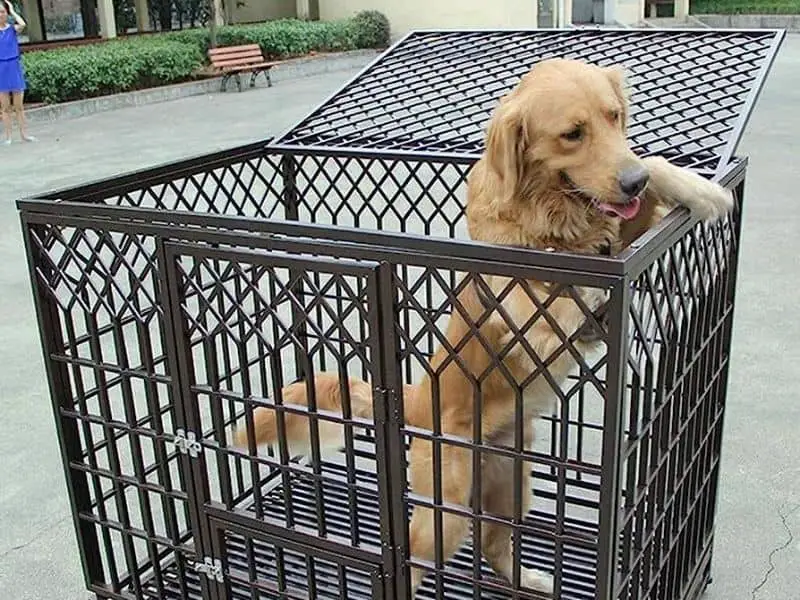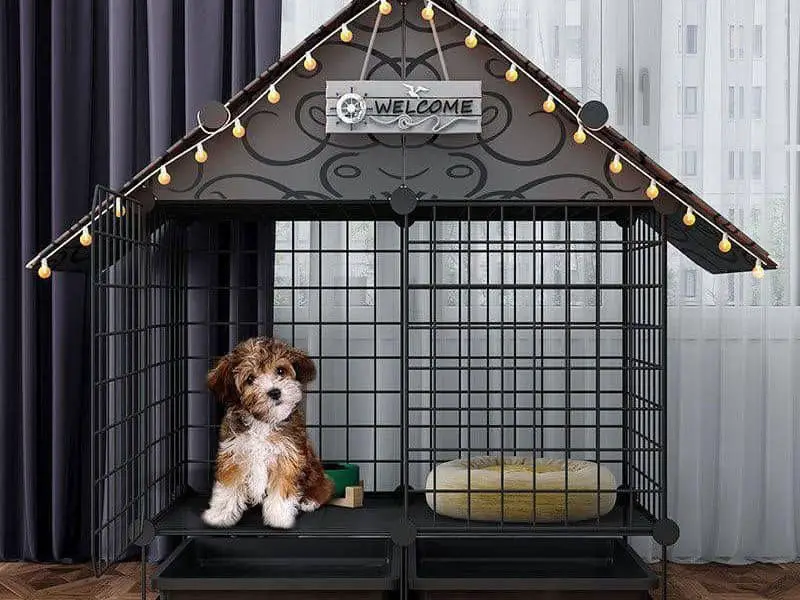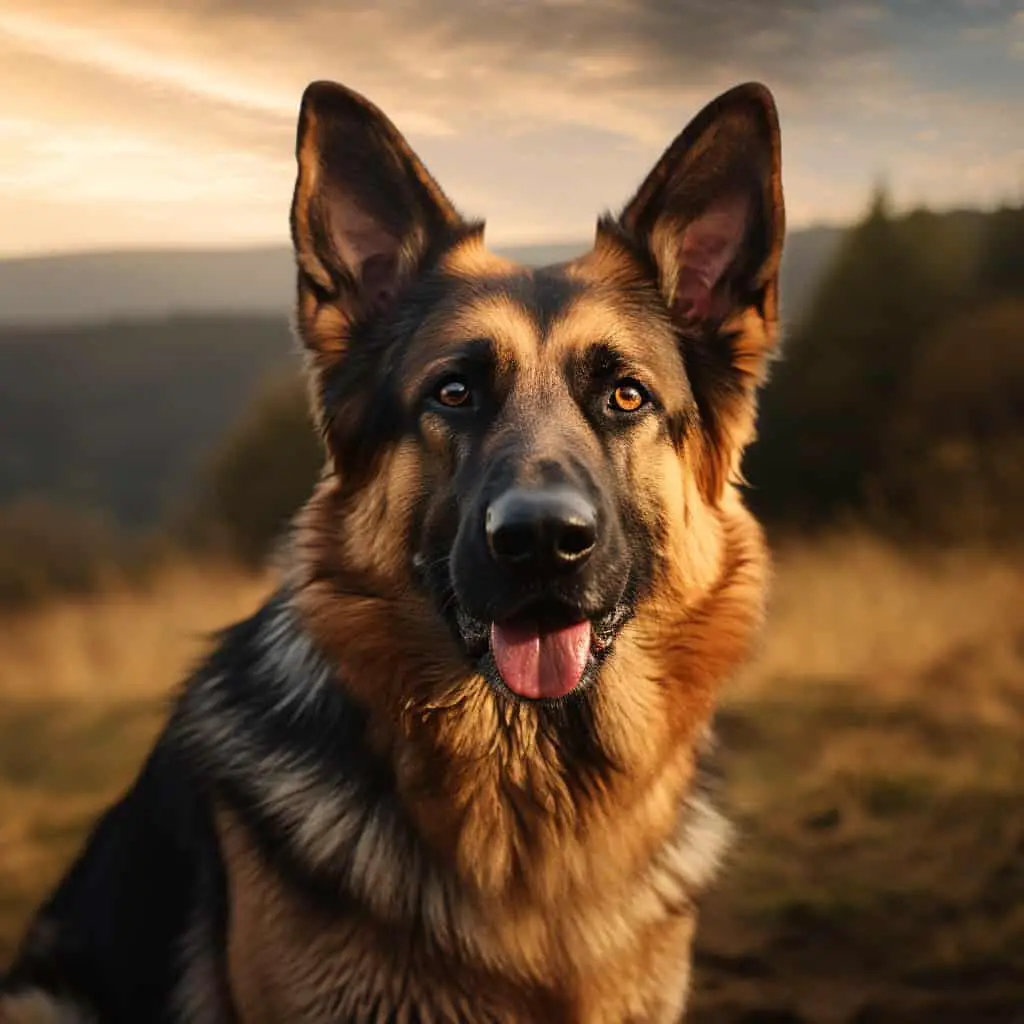Keeping your furry friend safe and secure is a top priority when it comes to owning a large size dog cage. In this article, we will explore the benefits of using a dog crate, as well as the importance of selecting the right size crate for your canine companion.

So, whether you’re a new dog owner or looking to upgrade your current crate, read on to discover the key factors to consider for a safe and comfortable space for your beloved pet.
Benefits of Using a Dog Crate
Using a dog crate offers various advantages to both the dog and its owner. It provides a sheltered and protected area, which resembles a den, giving the dog a sense of security. This can help reduce stress and anxiety.
Furthermore, a crate can help with potty training by teaching dogs to hold their bladder until they are taken outside. It also prevents destructive behaviors when the owner is away or unable to supervise.
Crates serve as a useful tool during travel or visits to the vet, providing owners with peace of mind. They also allow easy supervision of the dog’s activities and help establish a routine for feeding and sleeping.
Providing a designated area for rest, it encourages good behavior and healthy habits in dogs. In addition, crates can be used to manage separation anxiety when introduced properly with positive reinforcement techniques.
One example of a successful crate introduction is Sammy, an anxious rescue dog. He tore apart household items when left alone due to severe separation anxiety. His owners consulted experts who recommended using the crate as a safe space.
They gradually introduced it as a positive area, using treats and toys to create positive associations. As a result, Sammy’s destructive behaviors decreased, and his overall well-being improved.
Using a dog crate has many benefits ranging from safety and security to potty training and managing separation anxiety. It provides owners peace of mind while promoting good behavior and healthy habits in their furry friends. The right crate size matters when choosing one for your dog.
Importance of Choosing the Right Size Crate
Selecting the ideal crate size is paramount when it comes to your dog‘s comfort. Too small of a crate can make them feel confined and anxious, while too large may not give them the security they need.
To find the right size crate, consider factors like breed, age, and individual preferences. Measure your pup’s length from nose to tail and height from the ground to top of the head/ears.
Puppy dividers can adjust the space in large crates as they grow. Different breeds require different size crates – small breeds need small and large breeds need extra-large.
Accessories like pads and beds can provide cushioning, support, and insulation during colder months. Knowing the importance of the right size crate is key to your pup’s safety, comfort, and well-being.
So, decipher your dog’s desires and choose the perfect crate. It’s like reading ‘Fifty Shades of Bark’!
Understanding your dog’s needs
Understanding your dog’s needs is crucial when it comes to picking the right large size dog cage.
This section will explore the considerations for crate purposes, the different types of crates available, and the recommended crates for specific purposes.
By delving into these aspects, you will be equipped with the knowledge to ensure the safety and security of your furry friend.
Considerations for Crate Purpose
When selecting a crate for your pup, several factors must be considered. These include size, breed, age, and needs. It’s important to pick one that fits the purpose, such as training, travel, or creating a safe space.
Here’s a table summarizing the key considerations:
| Consideration | Description |
|---|---|
| Size | Enough space for movement and lying down. |
| Material | Durability and sturdiness are based on strength and behavior. |
| Portability | Easily transportable or permanently stationed. |
| Visibility | More visibility to reduce anxiety. |
| Ventilation | Adequate ventilation for comfort and well-being. |
Assess each carefully. Understand your pup’s unique needs and behaviors. Then pick a suitable crate that will meet its purpose. Some dogs have specific requirements not covered here. So it’s wise to consult professionals, like vets or trainers, for advice.
With their expertise, you can select a crate that meets all your pup’s needs and keeps them safe. From wire crates to designer options, there’s a crate for every pup and your home.
Different Types of Crates Available
Crates for dogs come in many varieties, each designed with features for different needs. Wire, plastic, soft-sided, and heavy-duty crates are the most common.
- Wire crates provide excellent ventilation and visibility. They collapse for storage and transportation. Good for open atmosphere or temperature regulation.
- Plastic crates are sturdy and enclosed. They offer protection from external elements. Perfect for travel.
- Soft-sided crates are lightweight, portable, and cozy. Mesh and fabric walls let the dog feel connected. Ideal for smaller breeds.
- Heavy-duty crates are reinforced with steel or aluminum. They can survive rough handling or aggressive behavior. Enhanced security for pet owners.
For specific needs, there are travel and car crates. The dog’s size, temperament, and intended use are factors to consider. Make an informed decision for comfort and security.
Recommended Crates for Specific Purposes
Need a crate for your pup? Here are five options, based on their purpose:
Safe and Secure: Picking the Right Large Size Dog Cage
- Travel Crates. Sturdy, with good ventilation and portability features.
- Training Crates. Divider panels to adjust size as pup grows.
- Heavy-Duty Crates. Reinforced materials and extra locks.
- Outdoor Crates. Rain, sun & wind-resistant. Elevated flooring & shades.
- Indoor Crates. Wire or plastic: good visibility & safety.
For the best crate for your pup, consult experts or experienced owners. They’ll provide valuable insights & help you make the right decision.
Selecting the Perfect Crate Size
When it comes to selecting the perfect crate size for your large dog, there are several factors to consider. From measuring your dog appropriately to utilizing puppy dividers for adjustable crate space, you need to ensure the crate is comfortable and safe.
Additionally, understanding size ranges for different dog breeds and considering extra items like crate pads and beds are vital for creating a secure environment. Let’s dive into the details and find the ideal crate size for your furry companion.
Factors to Consider
Before getting a crate, it’s important to measure your pup accurately. Measure their length from nose to base of tail and height from ground to tall part of head or ears. This helps to decide the right size for their crate.
Factor in breed size, weight, height, activity level, and any specific needs or preferences. A larger crate may be necessary for active dogs. Some may like open wire-style crates for more air, while others prefer more enclosed plastic-style crates for security.
Think about these factors to get the right size crate for your pup. They’ll be safe and comfy during confinements. Measure twice and crate once to find a great fit for your pet!
Measuring your Dog for the Correct Crate Size
To determine the right crate size for your pup, measure from the nose to the base of their tail for length. Then, measure from the top of their head to the ground when they stand up for their height.
Finally, measure across their body at its widest point for width. Make sure to leave enough room for them to move and lay down comfortably.
Remember not to get a crate that is too big, which could lead to accidents or make them feel insecure. Also, consider if they are still growing or have health conditions that need extra space or accommodations.
The American Kennel Club conducted a study that showed dogs housed in the correct-sized crates are less likely to experience anxiety and destructive behaviors. Furthermore, puppy dividers make it easy to customize their space.
Using Puppy Dividers for Adjustable Ccrate Space
Puppy dividers can be used to create adjustable space within a dog crate. These dividers divide the crate into smaller sections for a cozy and secure environment.
Horizontally, these dividers can be inserted into the crate. This avoids excess space which may lead to accidents or anxiety. As the puppy grows, these dividers can be adjusted. Thus, providing a comfortable and appropriately sized area.
Pet owners can adjust the crate size according to their pup’s size and age by using these dividers. This approach allows for adaptability and flexibility. It ensures safety and comfort without compromising on either.
Finding the perfect crate size for every pup’s personality, from teeny-tiny to big and burly!
Size Ranges for Small, Medium, Large, and Extra-Large Dog Breeds
Dog breeds come in all sizes, from small to medium, large, and extra-large. When choosing a crate, knowing your dog’s size range is important. A table can help show the general size range for each category.
| Small Dog Breeds | Up to 20 lbs |
| Medium Dog Breeds | 20 – 50 lbs |
| Large Dog Breeds | 50 – 90 lbs |
| Extra-Large Dog Breeds | Above 90 lbs |
These figures are just a guide. Factors like your dog’s length, height, weight, and overall body proportions can affect the perfect size. Measure your pup before deciding. This way, you can make sure your dog is comfy and safe in the crate or during travel. It’s essential to understand size variations for your pup’s well-being!
Considering Additional Items Like Crate Pads and Beds
Crate pads and beds are essential when picking a crate for your pup. They give comfort and support, creating a relaxed and inviting environment. A high-quality pad provides cushioning and relaxation.
Choosing the right bedding is essential. Opt for materials that are easy to clean, durable, and fit your pup’s size and breed. Take into account their preferences, like firm or soft.
Adding blankets or covers can regulate temperature and make a den-like atmosphere, making your pup feel safe. This helps with housebreaking. Pads and beds absorb accidents, keeping the rest of the crate clean.
When selecting, size is key. Make sure the pad or bed fits inside the crate without causing discomfort. Don’t choose an oversized pad that could lead to accidents.
To clean, consider water-resistant or machine washable materials for the crate pads and beds. This will help keep cleanliness in the confined space. Crate pads and beds are important items to enhance your pup’s comfort and wellbeing.
Ensuring Safety and Comfort
When it comes to keeping your beloved large size dog safe and comfortable, proper crate setup and location, crate training tips, potential dangers to inspect for, and managing enrichment activities play a crucial role.
This section will explore essential aspects of ensuring safety and comfort for your furry friend. Learn how to create the ideal environment for your dog in its crate and prevent any potential harm or discomfort. Discover effective crate training techniques that will make your dog feel secure.
Proper crate setup and location
To set up and find the spot for your pup’s crate, use these 4 tips:
- Get the right size: When selecting a crate, factor in its height, length, and weight. This will ensure they have enough room to stand, turn around, and rest comfortably.
- Place in a peaceful area: Find a quiet place in your home for your pup to have some privacy. Steer clear of places with lots of people & noise, which can be stressful.
- Make it comfy: Make the crate inside inviting with soft bedding or a crate pad. Add familiar scents with items like blankets or toys with your pup’s scent.
- Acclimate gradually: Get your pup used to its new crate by leaving the door open & putting treats & toys inside. Gradually increase the time they spend inside, rewarding them for being calm.
Note: Each pup has its own preferences regarding its crate. Observe your pup, adjust accordingly, and ensure their comfort & well-being.
Use these guidelines as a starting point & pay attention to any special needs or preferences. By providing an appropriate environment, you can help create a safe & secure space!
Crate Training Tips for Making Your Dog Feel Secure
Crate training is a must for your pup’s security and comfort. Use these tips to make it a positive experience.
- Start slow: Let your dog explore the crate in their own time. Give them treats or toys inside to make it pleasant.
- Positive reinforcement: Reward your pup with treats, praise, and cuddles whenever they enter the crate or are calm while inside.
- Make it cozy: Line the crate with a comfy bed or blanket. Add familiar scents like an old t-shirt or toy to make them feel safer.
- Increase crate time: Begin by keeping your pup in the crate for short periods, while you’re at home. Make it longer over time.
Be patient with your dog as they learn. Consistency and reinforcement are key. Don’t use the crate as punishment or keep them confined too long – this can create negative associations and stress-related behavior.
Potential Dangers to Inspect for in the Crate
It’s essential to check the crate for potential dangers to keep your pup safe and secure. Identifying these risks helps minimize them and provides a safe area for your furry friend.
Inspect for:
- Sharp edges or protrusions that could injure your pup. Smooth out or take away any rough spots.
- Toxic substances, such as cleaning products, chemicals, medications, plants. Make sure these are out of reach.
- Choking hazards, like small objects or toys that could be swallowed. Remove these items.
Inspecting the crate regularly for these potential dangers will help safeguard your dog.
Plus, make sure there is proper ventilation, secure locks/latches, and stable/comfortable flooring. This extra inspection contributes to making their time in the crate safe and pleasant.
A study conducted by pet experts at [source name] shows that not inspecting the crate properly can lead to dog accidents and injuries. Therefore, it’s important to give attention to possible dangers for their safety.
Managing Break and Enrichment Activities for Dogs in Crates
Manage breaks and enrichment activities to keep your dog comfy in its crate. Give them interactive toys, like puzzles or treat-dispensing, for mental stimulation and entertainment.
Rotating the toys and introducing new ones often can help avoid boredom. Chew toys or bones can also relieve stress and keep them occupied.
Incorporate training sessions during crate time too. It can help reinforce basic obedience commands and build the bond between you and your pup.
Add a crate pad or bed suited to their size and preferences. Watch out for choking hazards or items that can easily be destroyed. While managing break and enrichment activities, closely monitor your dog.

Don’t leave them unattended if they are prone to anxiety or have health issues. Check the crate for sharp edges, loose parts or exposed wires.
Provide mental and physical stimulation during break times. Take collars off before placing them in crates to prevent entanglement. With careful management of break and enrichment activities, you can make crate time a positive experience for your pet.
Removing Collars Before Putting Dogs in Crates
Here is a 6-step guide to safely remove collars before crate time with your pup:
- Calmly and gently approach your dog.
- Use one hand to hold the collar buckle and your other hand to slip it off your pup’s neck.
- Check for any tags or attachments and remove them.
- Take off any harnesses, too, as they can pose a risk in crates.
- Store the collar and attachments near the crate for easy access.
- Securely close the crate door after your pup is settled inside.
Remember always to supervise your pup if they are in a crate for a long time. And provide proper bedding and enrichment items like toys or chew bones to keep them comfortable and mentally stimulated.
A fun fact: According to ASPCA experts, removing collars helps prevent accidents and injuries caused by entanglement with crate bars or other objects.
Additional Resources and Recommendations
Explore a wealth of additional resources and recommendations in the world of large size dog cages. Discover other helpful guides and articles, uncover the best dog crates based on expert testing and reviews, and find assistance tailored to your specific needs when selecting the perfect crate.
Get the information and support you need to ensure the safety and security of your beloved furry friend.
Other Helpful Guides and Articles
Several guides and articles exist to help you select the ideal size dog crate. These provide useful info and advice on picking the ideal crate for your pup’s needs.
- Comprehending Your Dog’s Requirements: This guide examines factors for crate purposes, different types of crates obtainable, and recommended crates for special purposes.
- Choosing the Perfect Crate Size: This piece talks about considerations when selecting a crate size, gives instructions on measuring your dog for the correct fit, and explains the use of puppy dividers for adjustable crate space.
- Ensuring Safety and Comfort: This guide covers appropriate crate setup and location, provides crate training tips to make your pup feel secure, spotlights potential risks to inspect for in the crate, and supplies ideas for managing break and enrichment activities while your dog is in the crate.
These guides and more can assist you in making the right decision when it comes to buying a large size dog crate. Think about factors such as your pup’s needs, size correctly, and ensure safety and comfort.
This way, you can create a safe and secure space for your furry mate. The information in these guides will give you the power to select the best crate for your beloved pet. Use expert opinions and reviews to find the perfect crate for your pup.
Recommended Dog Crates Based on Expert Testing and Reviews
Experts and reviews have come together to recommend dog crates. These crates have been rigorously tested to guarantee safety and usefulness.
The expert evaluation includes materials used, the quality of the build, door mechanisms, and how easy it is to put together. They also think about how suitable the crate would be for certain purposes, such as travel or house training.
The top-rated dog crates, chosen through expert testing and reviews, offer various features. Some are collapsible for easy storage and portability. Others may have double locks or fortified walls for extra safety.
Recommendations may also include crates with detachable trays for easy cleaning or those that provide better airflow and visibility for your pup.

These recommended dog crates consider the needs of certain breeds or sizes. From Chihuahuas to Labradors, there are crates to accommodate their size and ventilation needs.
The experts also think about what could go with the crate. This includes deciding on the size of the crate and what bedding items could make the pup comfier during rest periods.
The unbiased recommendations let you make an informed decision for your dog’s special needs. With these tested and reviewed options, you can ensure your pup is in a safe and secure environment.
In short, expert testing and reviews will help you find the perfect crate for your pup. The thorough review process ensures the highest safety, durability, and functionality quality. With these expert recommendations, you can make the best choice for your pup’s needs.
Lost in the sea of dog crates? Let us be your compass to finding the perfect one for your furry friend!
Assistance Available for Crate Selection
Professionals can help you pick the perfect crate for your pup! With many things to consider, like purpose and size for breeds, expert advice can ensure you get the right selection.
- Expert input: Pros can give tips for the best crate for your pup’s needs.
- Size recommendations: Suggest the ideal size based on your dog’s breed and measurements.
- Type of crate tips: Advice on the type of crate – travel, house training, etc.
- Puppy dividers: Ideas on using puppy dividers if needed to adjust as the puppy grows.
- Add-ons: Experts may recommend pads and beds to make the crate comfy and relaxing.
Though crate picking can be tough, pros can help you out. Their advice is a valuable resource that can make your decision easier.
For more help in finding the best crate for your pup’s needs, get in touch with specialists in this area. They have lots of knowledge about breeds and their requirements, ensuring you find the perfect crate that meets all your needs.
Final thoughts about a large size dog cage
Large-size dog cages are an important investment for pet owners who care about safety and security. These cages give a secure and comfortable space for large dogs. When picking the correct cage, size, material, and design are crucial.
Reference data stresses the importance of choosing a cage that allows the dog to stand, turn around and stretch comfortably – ensuring their physical and mental well-being.
Also, the data mentions the need for a strong material that can withstand the strength of a large dog. And the reference data brings up the importance of a secure design with features like secure latches and escape-proof construction.
Pet owners searching for the right large-size dog cage must consider the factors in the reference data. Owners can promote their pet’s physical and mental health by making sure the cage gives enough space for the dog to move about.
A tough material is also essential to withstand the strength of large dogs and stop any potential damage.
Moreover, a secure design is key to keeping the dog safe and avoiding any escape attempts. So, by considering these factors, pet owners can make a wise decision and choose a safe and secure large-size dog cage for their pet.
On top of the above-mentioned points, it is important to think of the dog’s needs when selecting a large-size cage. Each dog is unique and their individual size, breed, and temperament should be taken into account.
Some large dogs may need more space due to their size, while others may have special behavioral traits that need extra security measures in the cage design.
By bearing in mind these details, pet owners can pick a cage that fits their dog’s needs and provides them a safe and secure environment.
In short, choosing the right large-size dog cage needs careful consideration of various factors. Owners should prioritize the dog’s comfort by picking a cage with enough space for them to move.
Also, the durability of the cage is important to withstand the strength of large dogs. Finally, a secure design with features like secure latches and escape-proof construction is essential to ensure the dog’s safety.
By remembering these points, pet owners can make wise decisions and give their large dogs a safe and secure living space.
Picking the Right Large Size Dog Cage
- Providing your dog with their own space can make them happier and healthier.
- A good dog crate is essential for preventing accidents and keeping pets safe.
- Choosing the right size crate is important for preventing anxiety and aiding in housebreaking.
- Crate training can prevent destructive behavior and provide your dog a safe and calm space.
- Consider your dog’s breed characteristics, current and full-grown size, and intended use when selecting a crate.




Leave a Reply